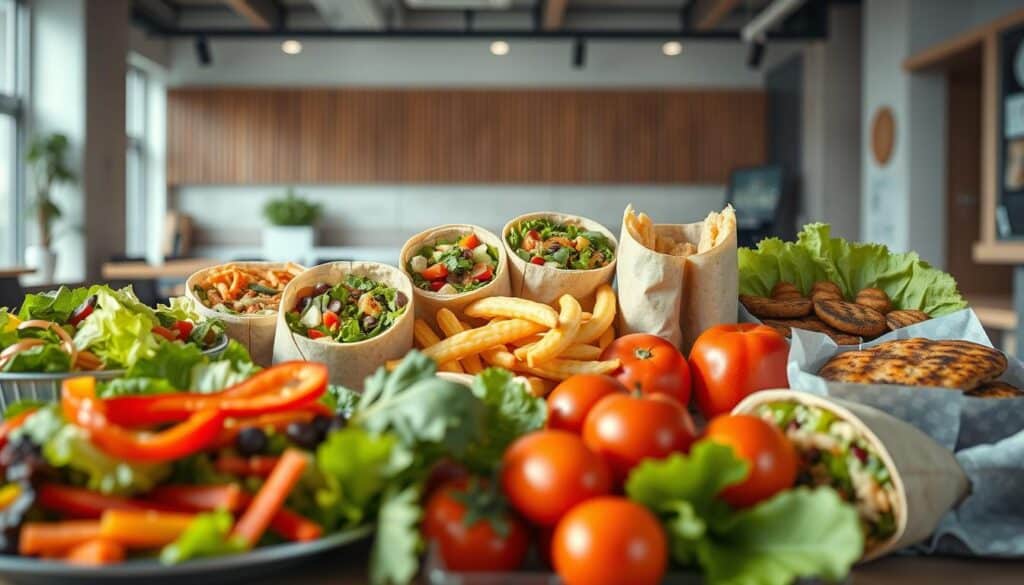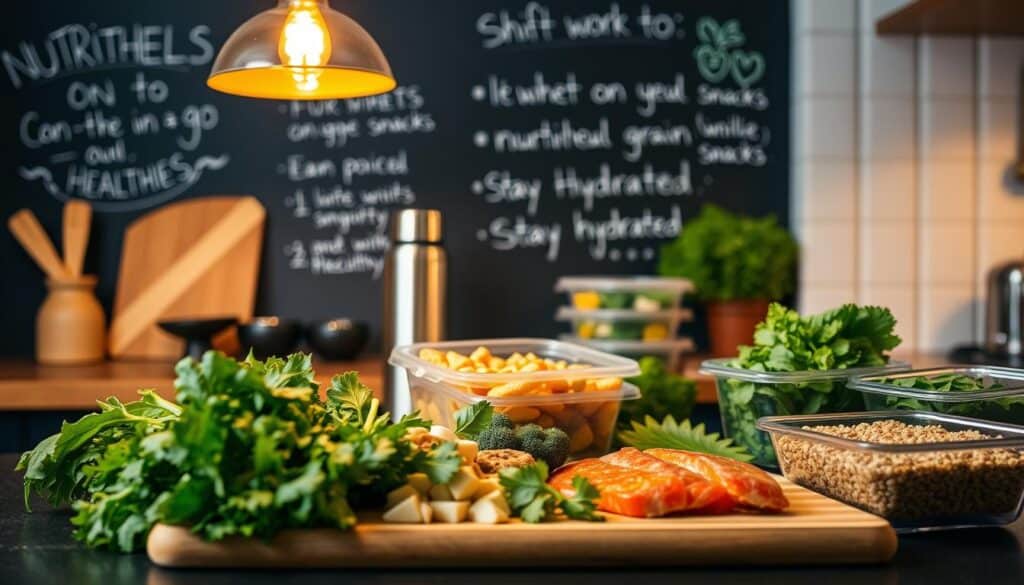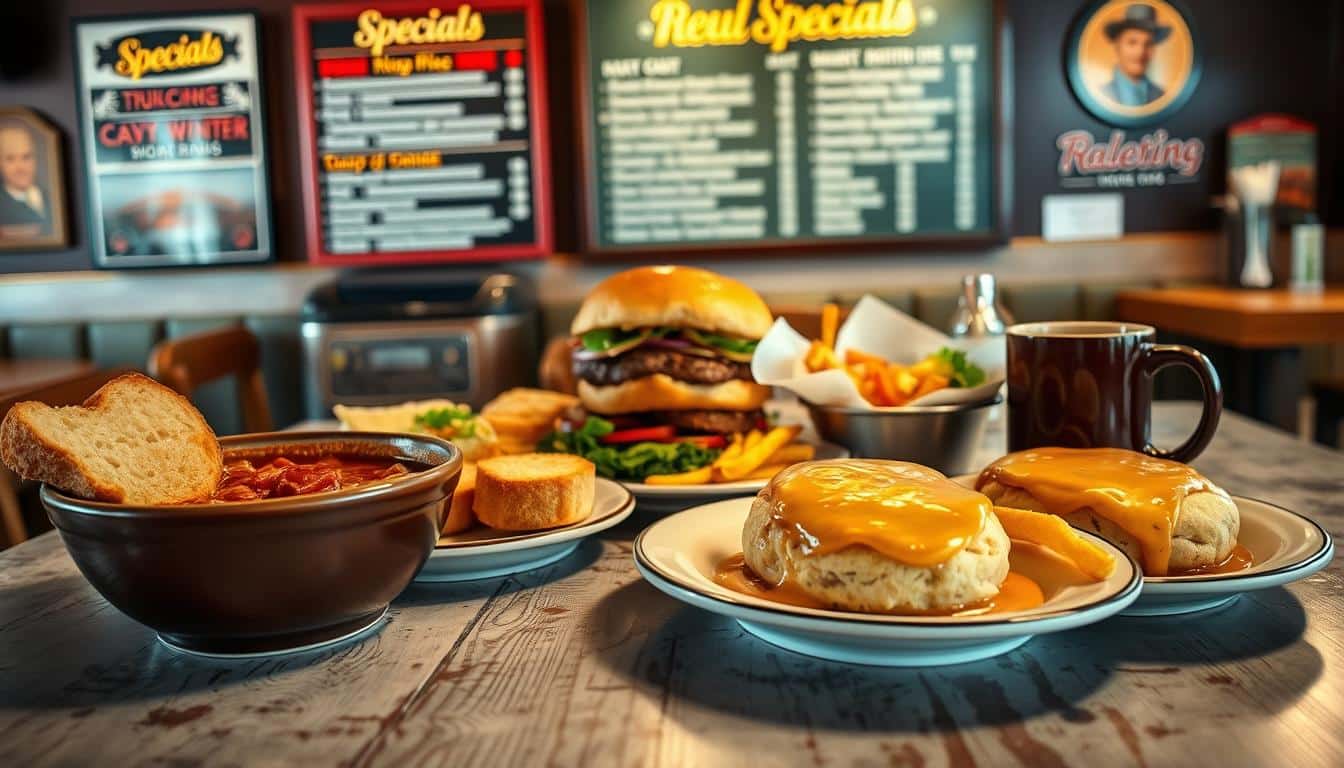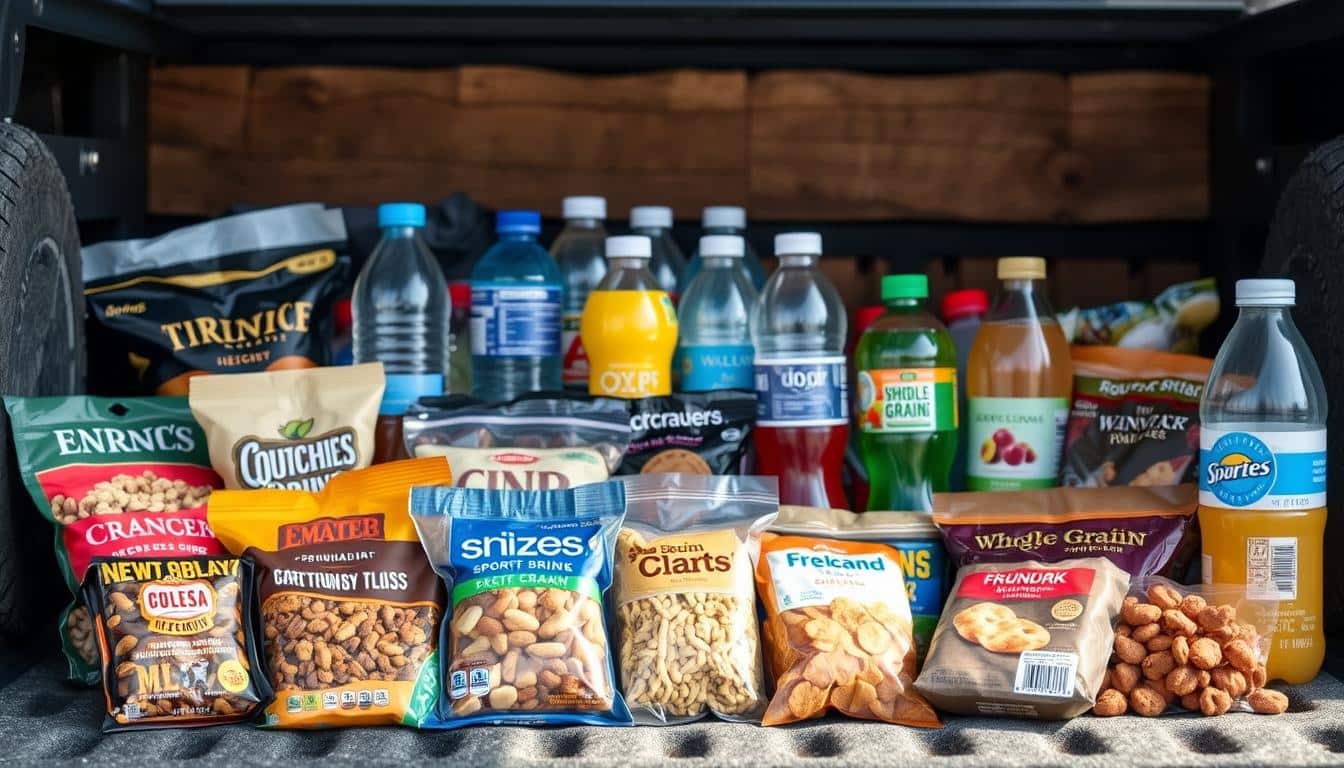Nutrition is super important for truck drivers, not just for health, but for safety too. This guide will show you how to eat well on the road. It helps cut down tiredness, keeps drivers healthy, and makes sure you stay sharp during long drives.
Eating right and staying active are key for a long driving career. You’ll get tips that are easy to follow at places like Love’s and Pilot/Flying J. These spots have started offering better food choices.
Get ready for useful advice on snacking smartly, drinking enough water, prepping meals, dining out wisely, understanding food labels, and handling weird work hours. These tips help drivers pass their health checks, avoid low energy, and remain focused and safe on the road.
Why nutrition matters for professional drivers
Good nutrition is key for drivers’ performance on the road. What they eat and drink affects their alertness, health, and stamina. It leads drivers to make smarter choices, reduce accident risks, and stay healthy for work.
Impact on safety and alertness
Eating habits can change how quickly you react and stay focused. While sweets may give a quick energy surge, they soon lead to a decrease in concentration. Eating balanced meals and choosing clever snacks help keep energy steady and avoid tiredness.
Staying hydrated is crucial. Water helps avoid tiredness and keeps your mind clear. Taking short walks during breaks refreshes you and makes long drives safer.
DOT physicals and long-term career health
DOT physicals check if drivers are healthy enough to work. Eating right helps manage blood pressure and sugar levels, and keep a healthy weight. This lowers the risk of being disqualified for health issues like high blood pressure or diabetes.
Keeping a good diet helps drivers stay healthy over time. A diet that focuses on balance and whole foods diminishes risks to a driver’s career.
How sugar, sodium, and dehydration affect driving performance
Eating too much sugar can cause energy highs and lows, increasing distraction risks. Over time, it also raises the chance of developing diabetes, which can impact your job.
High sodium intake can lead to higher blood pressure and heart issues. These conditions can affect your driving career and make passing DOT exams difficult.
Not drinking enough water can make you sleepy and slow down your thinking. It also raises the risk of kidney stones. Drinking plenty of water and eating a balanced diet prevent these issues and keep your performance high.
smart eating choices for professional drivers
Eating well makes long travels safer and more enjoyable. Planning meals and snacks helps avoid energy dips and cuts fast food use. For alertness while driving, choose foods rich in protein, fiber, and healthy fats.
Core principles: balance, portion control, and timing
Create balanced meals with lean proteins, whole grains, vegetables, and a bit of healthy fats. This combination fights hunger and keeps energy levels steady.
On the road, control your portions. Try asking for smaller servings, pack away part of your meal for later, or use small containers for snacks. Large meals often have too many calories, sodium, and sugar.
Plan your eating times around your driving schedule. Eat before a long drive and snack every 3-4 hours to avoid hunger pangs and eating too much later.
Choosing foods that support sustained energy and focus
Choose foods that keep your energy up and focus sharp. Good options are jerky, tuna, boiled eggs, grilled chicken, oatmeal, and whole-grain crackers.
Always have fruits, nuts, and hummus ready. They’re quick sources of energy and help avoid the sugar rush of convenience snacks.
Go for snacks that have both protein and fiber. This helps keep your blood sugar stable and your focus sharp on long drives.
How to read nutrition labels on the road
Here’s how to quickly use nutrition labels. Start with serving sizes. Many products have more than one serving but only list the nutrition for one.
- Choose items lower in sodium and added sugars.
- Look for higher protein and fiber to feel full longer.
- Favor short ingredient lists and claims like “low sodium” or “no added sugar.”
When comparing, check calories, sodium, added sugar, fiber, and protein. Quick checks can help make healthier choices without delaying your trip.
Healthy on-the-go snack options available at truck stops
Finding healthy snacks at truck stops is not hard. Smart choices help you stay energized without sugar crashes. Look for snacks that are easy to carry, store, and combine for balanced mini-meals.
Choosing high-protein snacks keeps you alert and helps muscles recover. Opt for low-sodium jerky with simple ingredients to skip additives. Quick protein like tuna, salmon, or mackerel pouches offer omega-3 benefits. Many truck stops also have pre-peeled hard-boiled eggs, a great snack or meal addition.
- Choose jerky, tuna pouches, eggs with less salt and fewer preservatives for health.
- To-go fish pouches are good with salads or crackers if you’re in a hurry.
- Combine hard-boiled eggs with whole-grain crackers for a smart snack choice.
Whole-grain snacks give truckers long-lasting energy. Air-popped or lightly seasoned popcorn is a whole-grain, fiber-filled choice. Be cautious with store-bought options as they may have too much salt. Go for plain varieties or bring your own popcorn. Pair whole-grain crackers with nut butter or cheese for a protein and carb boost that keeps you going.
- Truckers like plain popcorn, whole-grain crackers, and seeded rice cakes.
- Peanut butter or string cheese with crackers makes a great snack on the go.
Fresh fruit offers vitamins, fiber, and natural sweetness. Apples and bananas are good options as they don’t need refrigeration and are easy to eat. Mixed berries provide antioxidants and are a tasty choice when found at big truck stops. Keep some fruit handy for snacking during long trips.
- Apples and bananas are durable, mixed berries offer extra nutrition.
- Mix fruit with protein or whole grains to stabilize blood sugar levels.
Smart beverage strategies to stay hydrated and alert
What you drink affects your alertness, stamina, and comfort on long trips. Make smart drink choices. This helps you stay balanced during shifts. Drink slowly to prevent sudden energy drops and less bathroom stops.
Why water is the best primary hydration source
Water is number one for keeping you sharp and preventing tiredness. It also helps to stop kidney stones. Always start with water. Have a reusable bottle for easy sips, keeping you hydrated.
Alternatives: sparkling water, unsweetened teas, low-fat milk
Bubbly water is a great soda substitute without the sugar. You can find tasty, low-calorie flavors at truck stops. Unsweetened teas are a healthy choice. They offer flavor without too much sugar. Low-fat milk is good after a shift for protein and calcium.
- Choose unsweetened sparkling water over sugary drinks.
- Try plain tea for flavor and a little caffeine.
- Pick low-fat milk for nutrients after working.
Limit caffeine, sugary beverages, and impact on kidney health
Too much caffeine and sugar can dehydrate you and mess up your sleep. It also raises the risk of kidney stones. Keep an eye on caffeine. Swap some for water or tea to sleep better and stay alert.
Choose drinks with less sugar to avoid extra calories and kidney stress. Drink regularly for good kidney health. If coffee is a must, have water with it to stay hydrated.
Tips: drink every 20-30 minutes. Refill your bottle often. Check drink labels to dodge hidden sugars. Choosing the right drinks helps maintain energy and avoid tiredness while driving at night.
Meal planning and prepping for life on the road
Good planning changes long trips into healthy habits. A few tools and the right habits make meals easy, less expensive, and let drivers eat well even when they’re busy. Making small changes at home can have a big impact on the road.
Start with a high-quality cooler or a 12V fridge designed for trucks. A portable fridge for drivers keeps foods like yogurt, cooked chicken, and string cheese fresh for days. Combine this with strong meal prep containers and ice packs. This helps reduce stops for fast food and cuts down on wasted food.
Batch cooking is a time-saver for truckers and helps control portion sizes. Grill lean proteins, such as chicken or turkey meatballs. Roast vegetables and cook brown rice or quinoa. Then, divide it all into containers for easy, ready-to-warm meals at rest stops or with a food warmer.
- Pack lasting items: rolled oats, canned tuna, nut butter, whole-grain crackers, and apples.
- Choose microwave-safe containers for quick reheating at travel centers.
- Mark containers with dates to use the freshest meals first.
Meal kits help a lot on the road when you prepare ahead. Brands like Blue Apron or HelloFresh send ingredients to your home. You can portion and freeze these meals to take with you. These kits save on shopping time and keep dinners interesting and healthy.
Trucker meal prep includes easy changes for better nutrition. Add a side of greens or roasted carrots to your main meal. Keep snacks like hummus or Greek yogurt handy for quick bites during breaks.
- Set aside one day each week for batch cooking.
- Make sure to pack your cooler, ice packs, containers, and reusable utensils.
- Mix between meal kits and home-cooked batches to keep meals exciting.
Keeping regular habits helps avoid unplanned purchases and keeps your energy up. The right cooler or portable fridge and regular meal prep make the road less daunting. Planning your meals thoughtfully makes eating healthy easy and budget-friendly, no matter the distance.
Making healthier choices at restaurants and fast-food stops
Eating out doesn’t mean giving up on healthy food. You can make smart choices to fuel your travels, cut bad calories, and keep your blood pressure in check.

Choose grilled or baked proteins.
- Opt for grilled chicken, baked fish, or broiled lean meats over fried options. This change cuts down on bad fats and calories while keeping the protein you need.
- At places like Chick-fil-A or Subway, choosing a grilled chicken sandwich over fried can save you from extra fat and calories.
Swap sides for vegetables or salads and watch portions.
- Choose steamed veggies, side salads, or fresh fruit instead of fries. These small swaps reduce calories and increase fiber.
- If your meal looks too big, ask for a smaller portion or a box to take it home. This helps you avoid eating too much, especially during long trips.
Customize orders to reduce sodium, sugar, and fat.
- Request dressings and sauces on the side. Use them sparingly or skip creamy ones to cut down on fat and sugar.
- Say no to added salt, go for whole-grain buns, and leave out the mayo to lessen sodium and unnecessary fats.
- Before you stop, look up the menu and nutritional information online. Planning lets you choose healthier fast food that aligns with your health goals.
For truck drivers, little changes make a big difference. Follow these restaurant tips: prefer grilled over fried, pick lighter sides, and ask for less sodium. These habits maintain your energy and turn roadside dining into a health benefit.
Building a healthy truck pantry and snack stash
Having good food choices available on the road is key. A well-stocked healthy truck pantry reduces the need to stop, saves money, and helps avoid the lure of snack machines. Here are practical items and tips for stocking up that suit a trucker’s lifestyle.
- Mixed nuts and sunflower seeds provide protein, healthy fats, and magnesium. Choose raw or dry-roasted versions with less salt to keep sodium in check.
- Canned or pouched fish—tuna, salmon, sardines—are great for stable protein and omega-3s, boosting heart and brain health.
- Whole-grain crackers or instant oats give fiber and steady energy. They’re good with nut butter or canned fish.
Healthy convenience items
- Protein bars are a quick meal replacement. Look for bars with low added sugar, at least 10–15 grams of protein, and some fiber.
- String cheese and small cheese cubes are perfect with a cooler. They offer calcium and the protein snacks needed for lasting fullness.
- Single-serve hummus packs are great with veggies or whole-grain crackers. They offer a healthy alternative to usual gas-station snacks.
Stocking smart to avoid impulse junk-food purchases
- Make a shopping list before each stop. This helps avoid impulse buys like chips, candy, and sugary drinks at truck stops.
- Don’t keep tempting snacks within easy reach. If only healthy options are available, it’s easier to eat well and skip junk food.
- Rotate your supplies weekly. Use the oldest items first and restock regularly. This keeps your nonperishable snacks fresh and appealing.
Small steps lead to big health improvements. Keep a cooler for fresh items and a crate for dry goods. Restock your staples during regular grocery trips. Having a variety of shelf-stable and refrigerated snacks within reach helps keep drivers healthy and focused.
Practical tips for eating with shift work and irregular schedules
Working shifts with odd hours makes eating right hard. Stick to simple eating plans around your breaks and sleep times. Small changes in when you eat can keep your blood sugar stable, making driving safer.

Planning meal and snack timing around driving shifts
Try to eat small, well-rounded meals every 3–4 hours. Bring a variety of snacks to eat quickly during short stops. This way, you won’t go too long without eating and end up overeating.
- Pack portioned snacks: nuts, fruit, Greek yogurt cups.
- Set alarms to remind you to eat regularly, even when busy.
- Use a cooler or portable fridge to keep protein and veggies fresh.
Managing late-night and overnight eating to protect sleep
For late shifts, eat lighter meals before bedtime. Stay away from heavy, greasy food. Choose lean protein, veggies, and complex carbs in small amounts for overnight snacks.
- Choose turkey or tuna with salad instead of fries.
- Limit caffeine in the last 4–6 hours before bed.
- Opt for simple swaps like an apple with peanut butter over candy.
Strategies to prevent energy crashes and overeating
Eat foods with protein and fiber for longer-lasting energy. Snacks like hummus and carrots, jerky and an orange, or almonds and a banana are better than sweets. These choices help you avoid energy lows when you can’t stop for a break.
- Watch your sugar: choose whole fruit instead of soda and candy.
- Take short walks or stretch during breaks to stay alert.
- Have a mix of meals and snacks ready to dodge fast food urges.
These tips for eating on shift help you stay alert and recover better while working. Being prepared makes it easier to eat healthy and avoid overeating after a long drive.
Quick exercise and lifestyle habits that support healthy eating
Moving a bit and having simple routines can make eating healthy easier for drivers. Small habits can lessen stiffness, help avoid cravings, and keep you focused on long trips. At rest stops, use the space to move, and remember to follow sleep and hygiene habits to keep your energy and immune system strong.
Simple walking and stretching routines at truck stops
Walk quickly for 10–20 minutes around the lot or rest area to help your heart and clear your mind. These exercises are perfect for short breaks and help get your blood moving after sitting for too long.
Try easy stretches next to your truck like calf raises, reaching for your toes, rolling your shoulders, and moving your neck. Doing these light movements for a couple of minutes each can relax tight muscles and stop cramps.
Hydration, sleep, and hygiene practices for overall health
Always have a water bottle close by and drink often to stay hydrated. Drinking water often fights tiredness, is good for your kidneys, and can help you sleep better.
Make sure your sleeping spot is dark and quiet, and avoid caffeine before bed. Washing hands often, keeping bedding clean, and doing laundry regularly can reduce the chance of getting sick so you can drive more.
How regular activity helps control weight, blood pressure, and glucose
Just a little activity each day can greatly benefit your health. Daily walks and moving more can help control weight, lower blood pressure, and manage blood sugar by making your body more responsive to insulin.
These actions can also help drivers meet health standards and lower their risk of chronic diseases. Start with quick activities and increase them as you have more time to keep making progress.
- Quick routine: 10-minute walk, 3-minute neck and shoulder mobility, 3-minute lower-body stretch.
- Hydration tip: set hourly water goals and track with a labeled bottle.
- Sleep hygiene: blackout curtains or eye mask plus a white-noise app help create restful stops.
Tips for choosing lower-sodium and lower-sugar options
Keeping sodium and added sugar low is key for long trips. Making smart choices at stops and in your cab keeps you sharp and healthy. Reading labels and controlling portions fit well into a driver’s life.
Identifying high-sodium culprits
- Processed meats like pepperoni and beef jerky are often high in salt. Try to choose low-sodium options when you can.
- Canned soups and fish might have a lot of sodium. Look for versions with no added salt or less sodium.
- Snacks like flavored chips and salted nuts can add a lot of sodium. Go for unsalted or lightly salted ones instead.
Swapping sweets for smarter treats
- Instead of candy and pastries, try dark chocolate or fruits for energy without the crash.
- Top plain Greek yogurt with fruit for a tasty, low-sugar snack that fills you up.
- For a sweet fix, opt for dried fruit without extra sugar, but keep portions small.
Practical label comparison and portion control techniques
- Quickly compare labels to check the sodium and sugar content per serving.
- Always check the serving size to eat the right amount. If a package has more than one serving, divide it up beforehand.
- Look for items labeled “low sodium” or “no added sugar” or those with few ingredients to avoid hidden sodium and sugar.
These tips help truckers make smart food choices every day. By swapping out salty and sugary snacks for healthier options, it’s easier to stay on track. And paying attention to labels helps you enjoy treats without going overboard.
Conclusion
This driver health summary gives you everyday tips to follow. Focus on drinking plenty of water and eating lean protein, whole grains, fruits, vegetables, and healthy fats. Using a cooler or portable fridge, along with meal planning and portion control, helps make healthier choices easier during long trips.
Keep your truck filled with healthy snacks like mixed nuts, tuna pouches, popcorn, apples, and bananas. At truck stops like Love’s, TA/Petro, and Pilot/Flying J, pick healthier food when you need to. Choose grilled options, pick veggies over other sides, and pay attention to sodium and sugar to keep your DOT certification safe and ensure your health on the road.
Start simple routines: cook meals in bulk at home, try meal kits, and take walks or stretch during breaks. These steps improve your alertness and safety. They also help you have a longer, healthier driving career. Making smart eating choices and staying active brings big benefits for your performance and health over time.
FAQ
Why does nutrition matter for professional drivers?
How do food choices impact safety and alertness behind the wheel?
Can poor nutrition affect my ability to pass a DOT physical?
How do sugar, sodium, and dehydration specifically affect driving performance?
What are the core principles of smart eating on the road?
Which foods support sustained energy and focus while driving?
How can I read nutrition labels quickly while shopping at a truck stop?
What high-protein snack options are convenient at truck stops?
Are there healthy whole-grain and fiber snacks I can get on the road?
What portable fruits and produce travel well for drivers?
Why is water the best hydration choice for truck drivers?
What are acceptable beverage alternatives to water?
How much should I limit caffeine and sugary drinks?
What equipment is worth investing in for meal prep on the road?
What are easy batch-cooking ideas for drivers?
Are meal kits useful for drivers who want home-cooked options?
How can I pick healthier options at restaurants and fast-food stops?
What simple customizations reduce sodium, sugar, and fat in orders?
What nonperishable staples should I stock on the truck?
Which convenience items are healthiest for quick snacks?
How do I avoid impulse junk-food purchases at truck stops?
How should drivers plan meal and snack timing around irregular shifts?
What are strategies for late-night or overnight eating that protect sleep?
How can I prevent energy crashes and overeating on long hauls?
What quick exercise routines work well at truck stops?
How do hydration, sleep, and hygiene support overall health on the road?
Can short daily activity help control weight, blood pressure, and glucose?
What common foods are highest in hidden sodium?
What are healthy swaps for sweets and desserts?
How can I use portion control and label comparisons effectively on the road?
Content created with the help of Artificial Intelligence.



